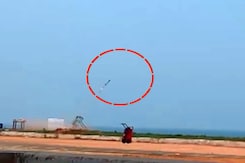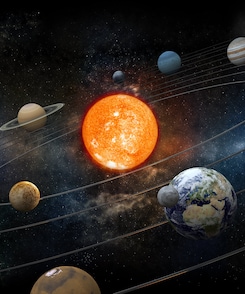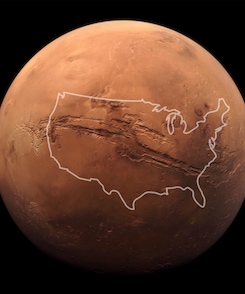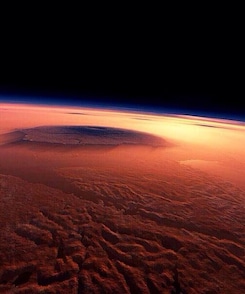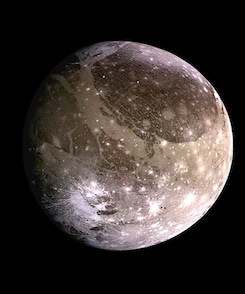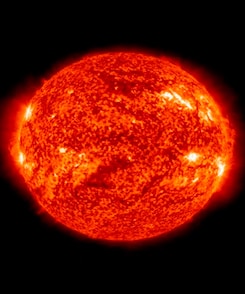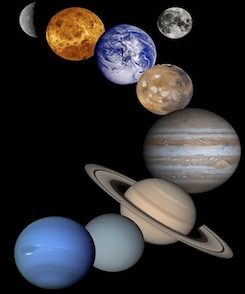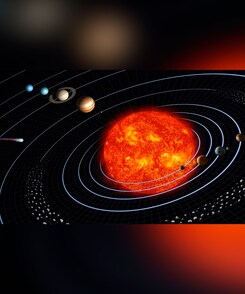Solar System
- All
- News
- Videos
- Photos
- Web Stories
-

Interstellar Comet 3I/ATLAS to Make Closest Approach to Earth on December 19
- Thursday December 18, 2025
Interstellar comet 3I/ATLAS will make its closest approach to Earth on Dec. 19, passing safely at a vast distance. Discovered by NASA-funded telescopes, the rare visitor offers scientists a valuable chance to study material formed around another star. Observations from space telescopes are expected to deepen understanding of interstellar objects.
-
 www.gadgets360.com
www.gadgets360.com
-

NASA’s Parker Solar Probe Observes Solar Wind Making ‘U-Turn’, Shedding Light on Space Weather
- Wednesday December 17, 2025
NASA’s Parker Solar Probe captured solar wind reversing toward the sun, revealing how magnetic fields recycle coronal material. This process, seen during a close flyby, helps refine models of space weather and may allow scientists to better predict solar storms that can impact satellites, communications, and power systems across the solar system.
-
 www.gadgets360.com
www.gadgets360.com
-

Interstellar Comet 3I/ATLAS To Make Closest Flyby Of Earth On December 19
- Tuesday December 16, 2025
- Science |
Interstellar comet 3I/ATLAS, discovered by NASA-funded telescopes, will pass Earth on December 19 at a safe distance of 270 million km.
-
 www.ndtv.com
www.ndtv.com
-

Elon Musk Slams Nuclear Energy As 'Super Dumb', Declares Solar Power The Real Future
- Tuesday December 16, 2025
- Offbeat |
Elon Musk's solar business, anchored by the 2016 Tesla-SolarCity merger, now operates under Tesla Energy, offering solar panels, Solar Roof systems, and battery storage to promote renewable home energy solutions.
-
 www.ndtv.com
www.ndtv.com
-

Scientists Study Ancient Interstellar Comet 3I/ATLAS, Seeking Clues to Early Star System Formation
- Sunday December 14, 2025
Comet 3I/ATLAS, a rare interstellar visitor from beyond the solar system, is putting on a striking celestial show as it nears Earth. After passing perihelion in October, the comet brightened nearly tenfold and shifted from red to green due to glowing carbon molecules. Tracked closely by astronomers worldwide, this ancient object offers a unique opp...
-
 www.gadgets360.com
www.gadgets360.com
-

Ahead Of Closest Approach To Earth, A Look At 3 Latest Images Of Interstellar Comet 3I/ATLAS
- Tuesday December 9, 2025
- Science |
The comet was detected on July 1, 2025, by the Asteroid Terrestrial-impact Last Alert System (ATLAS) survey telescope in Chile.
-
 www.ndtv.com
www.ndtv.com
-

Misaligned Exoplanet Is Challenging How We Think Solar Systems Form
- Friday December 5, 2025
Astronomers studying the dwarf-star system TOI-3884b have uncovered a striking anomaly: the planet’s orbit is sharply misaligned with its star’s rotation. Using multicolour transit observations, researchers detected repeated starspot-crossing events that revealed the planet passes over cooler regions on the stellar surface. Follow-up monitoring...
-
 www.gadgets360.com
www.gadgets360.com
-

A Nearby Planet May Have Formed the Moon Following a Collision With Early Earth: Study
- Wednesday December 3, 2025
A new analysis of Apollo samples and Earth rocks suggests that a nearby rocky planet, not a distant object, collided with early Earth and formed the moon. The study argues that this lost planet, Theia, originated in the inner solar system and shared Earth’s early neighbourhood, offering fresh insight into one of the most important events in our p...
-
 www.gadgets360.com
www.gadgets360.com
-

Scientists Find Clock on Mars Runs 477 Microseconds Faster Than Earth
- Thursday December 4, 2025
A new study by NIST physicists shows that clocks on Mars run about 477 microseconds faster per day than identical clocks on Earth. The difference comes from Mars’s weaker gravity, orbital eccentricity, and gravitational influences across the solar system. Though tiny, this daily time lead will pose challenges for future Mars navigation and commun...
-
 www.gadgets360.com
www.gadgets360.com
-

NASA Confirms Third Interstellar Visitor 3I/ATLAS Is a Natural Comet
- Sunday November 30, 2025
NASA has confirmed that interstellar object 3I/ATLAS is a natural comet, not alien technology. The comet shows unusual carbon-dioxide and nickel vapours, offering a rare look at ancient material from another star. Its path is safe, staying about 1.8 AU from Earth during its Solar System passage.
-
 www.gadgets360.com
www.gadgets360.com
-

NASA’s Perseverance May Have Found Its First Meteorite on Mars
- Wednesday November 26, 2025
NASA’s Perseverance rover may have discovered its first meteorite on Mars, a 31-inch iron-nickel boulder named Phippsaksla found in Jezero Crater. Its pitted, coral-like texture and unusually high metal content resemble meteorites previously identified by Curiosity, Spirit, and Opportunity. Scientists are now analysing the rock’s composition in...
-
 www.gadgets360.com
www.gadgets360.com
-

Icy Moons Might Have Oceans That Briefly Boil, Study Suggests
- Thursday December 4, 2025
A new study suggests that icy moons such as Mimas and Enceladus may host boiling subsurface oceans triggered by thinning ice shells and falling pressure. This low-temperature boiling could still support life beneath the surface. The research also explains geological features on larger icy moons and strengthens their potential as sites for finding e...
-
 www.gadgets360.com
www.gadgets360.com
-

Boiling Oceans May Hide Beneath Icy Moons, New Study Suggests
- Wednesday November 26, 2025
A new study suggests that icy moons such as Mimas and Enceladus may host boiling subsurface oceans triggered by thinning ice shells and falling pressure. This low-temperature boiling could still support life beneath the surface. The research also explains geological features on larger icy moons and strengthens their potential as sites for finding e...
-
 www.gadgets360.com
www.gadgets360.com
-

Interstellar Comet 3I/ATLAS to Make Closest Approach to Earth on December 19
- Thursday December 18, 2025
Interstellar comet 3I/ATLAS will make its closest approach to Earth on Dec. 19, passing safely at a vast distance. Discovered by NASA-funded telescopes, the rare visitor offers scientists a valuable chance to study material formed around another star. Observations from space telescopes are expected to deepen understanding of interstellar objects.
-
 www.gadgets360.com
www.gadgets360.com
-

NASA’s Parker Solar Probe Observes Solar Wind Making ‘U-Turn’, Shedding Light on Space Weather
- Wednesday December 17, 2025
NASA’s Parker Solar Probe captured solar wind reversing toward the sun, revealing how magnetic fields recycle coronal material. This process, seen during a close flyby, helps refine models of space weather and may allow scientists to better predict solar storms that can impact satellites, communications, and power systems across the solar system.
-
 www.gadgets360.com
www.gadgets360.com
-

Interstellar Comet 3I/ATLAS To Make Closest Flyby Of Earth On December 19
- Tuesday December 16, 2025
- Science |
Interstellar comet 3I/ATLAS, discovered by NASA-funded telescopes, will pass Earth on December 19 at a safe distance of 270 million km.
-
 www.ndtv.com
www.ndtv.com
-

Elon Musk Slams Nuclear Energy As 'Super Dumb', Declares Solar Power The Real Future
- Tuesday December 16, 2025
- Offbeat |
Elon Musk's solar business, anchored by the 2016 Tesla-SolarCity merger, now operates under Tesla Energy, offering solar panels, Solar Roof systems, and battery storage to promote renewable home energy solutions.
-
 www.ndtv.com
www.ndtv.com
-

Scientists Study Ancient Interstellar Comet 3I/ATLAS, Seeking Clues to Early Star System Formation
- Sunday December 14, 2025
Comet 3I/ATLAS, a rare interstellar visitor from beyond the solar system, is putting on a striking celestial show as it nears Earth. After passing perihelion in October, the comet brightened nearly tenfold and shifted from red to green due to glowing carbon molecules. Tracked closely by astronomers worldwide, this ancient object offers a unique opp...
-
 www.gadgets360.com
www.gadgets360.com
-

Ahead Of Closest Approach To Earth, A Look At 3 Latest Images Of Interstellar Comet 3I/ATLAS
- Tuesday December 9, 2025
- Science |
The comet was detected on July 1, 2025, by the Asteroid Terrestrial-impact Last Alert System (ATLAS) survey telescope in Chile.
-
 www.ndtv.com
www.ndtv.com
-

Misaligned Exoplanet Is Challenging How We Think Solar Systems Form
- Friday December 5, 2025
Astronomers studying the dwarf-star system TOI-3884b have uncovered a striking anomaly: the planet’s orbit is sharply misaligned with its star’s rotation. Using multicolour transit observations, researchers detected repeated starspot-crossing events that revealed the planet passes over cooler regions on the stellar surface. Follow-up monitoring...
-
 www.gadgets360.com
www.gadgets360.com
-

A Nearby Planet May Have Formed the Moon Following a Collision With Early Earth: Study
- Wednesday December 3, 2025
A new analysis of Apollo samples and Earth rocks suggests that a nearby rocky planet, not a distant object, collided with early Earth and formed the moon. The study argues that this lost planet, Theia, originated in the inner solar system and shared Earth’s early neighbourhood, offering fresh insight into one of the most important events in our p...
-
 www.gadgets360.com
www.gadgets360.com
-

Scientists Find Clock on Mars Runs 477 Microseconds Faster Than Earth
- Thursday December 4, 2025
A new study by NIST physicists shows that clocks on Mars run about 477 microseconds faster per day than identical clocks on Earth. The difference comes from Mars’s weaker gravity, orbital eccentricity, and gravitational influences across the solar system. Though tiny, this daily time lead will pose challenges for future Mars navigation and commun...
-
 www.gadgets360.com
www.gadgets360.com
-

NASA Confirms Third Interstellar Visitor 3I/ATLAS Is a Natural Comet
- Sunday November 30, 2025
NASA has confirmed that interstellar object 3I/ATLAS is a natural comet, not alien technology. The comet shows unusual carbon-dioxide and nickel vapours, offering a rare look at ancient material from another star. Its path is safe, staying about 1.8 AU from Earth during its Solar System passage.
-
 www.gadgets360.com
www.gadgets360.com
-

NASA’s Perseverance May Have Found Its First Meteorite on Mars
- Wednesday November 26, 2025
NASA’s Perseverance rover may have discovered its first meteorite on Mars, a 31-inch iron-nickel boulder named Phippsaksla found in Jezero Crater. Its pitted, coral-like texture and unusually high metal content resemble meteorites previously identified by Curiosity, Spirit, and Opportunity. Scientists are now analysing the rock’s composition in...
-
 www.gadgets360.com
www.gadgets360.com
-

Icy Moons Might Have Oceans That Briefly Boil, Study Suggests
- Thursday December 4, 2025
A new study suggests that icy moons such as Mimas and Enceladus may host boiling subsurface oceans triggered by thinning ice shells and falling pressure. This low-temperature boiling could still support life beneath the surface. The research also explains geological features on larger icy moons and strengthens their potential as sites for finding e...
-
 www.gadgets360.com
www.gadgets360.com
-

Boiling Oceans May Hide Beneath Icy Moons, New Study Suggests
- Wednesday November 26, 2025
A new study suggests that icy moons such as Mimas and Enceladus may host boiling subsurface oceans triggered by thinning ice shells and falling pressure. This low-temperature boiling could still support life beneath the surface. The research also explains geological features on larger icy moons and strengthens their potential as sites for finding e...
-
 www.gadgets360.com
www.gadgets360.com

















